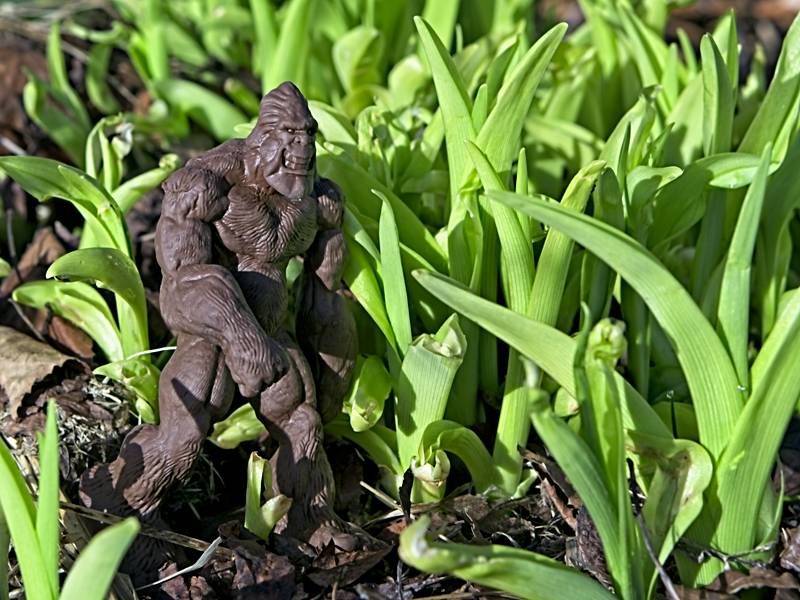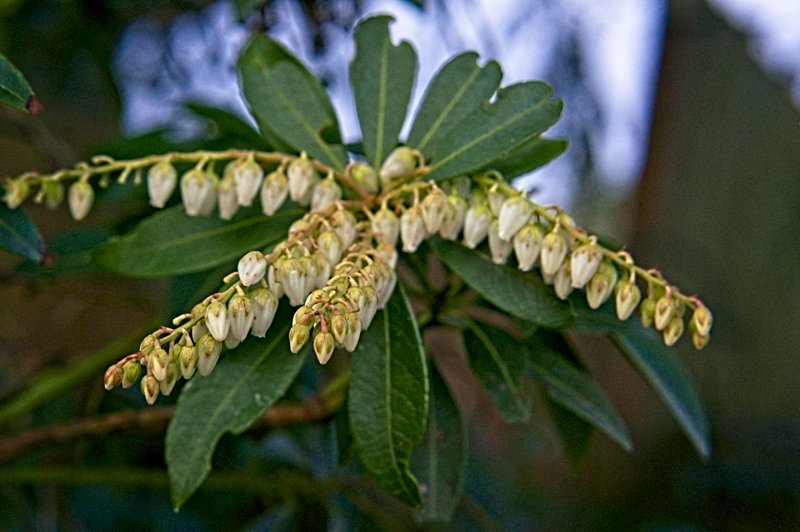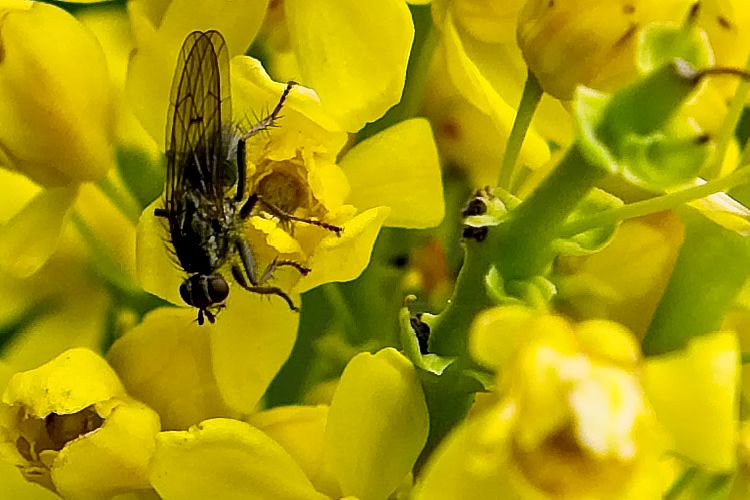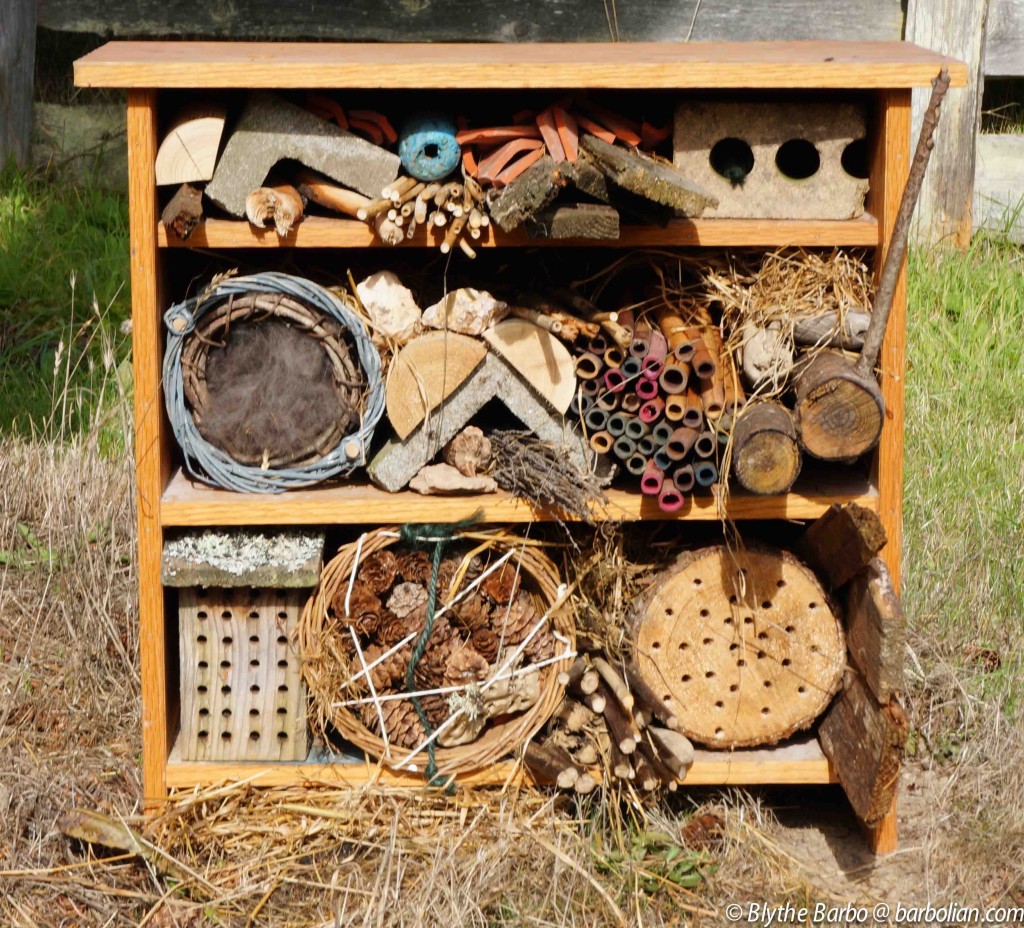Late winter / pre-spring is a critical time for pollinators first emerging from winter havens. In this post, I take a look at what plants I have blooming at this tumultuous time of year – and also look at some general ideas for planning a garden for pollinators.
And, as it works, th’ industrious bee
~Andrew Marvell, “The Garden”
Computes its time as well as we.
How could such sweet and wholesome hours
Be reckoned but with herbs and flowers!

February is a month of firsts: first crocus; first emergence of the rhubarb; first pussy willows; first frogs. Yesterday I saw my first blossom on a purple deadnettle plant growing at the edge of the driveway. Yay! The bumbles just love this plant, and although considered a weed, I have often delayed planting spring vegetables to allow more time for the bumbles to forage where great swaths of this plant tend to spread.
Although still officially winter, pollinators are already emerging from their winter havens. What will they eat?
Quick Links in this Blogpost:Planning a Garden for Pollinators
Taking Inventory: The Walk-Around and See Approach
My goal is to create a garden that provides habitat and continuous bloom and diversity for a variety of pollinators all year long (or close). The best way to know what is blooming right now is to just go out and look (duh!). You think you know… but had I relied on my thoughts, I wouldn’t have seen the tiny pink violas growing in the center of the Willow Room… and that was rather magical.
Here’s what I have blooming right now (late February):
Trees & Shrubs:
Cornelian Cherry
Hazels
Indian Plum / Osoberry
Oregon Grape
Pieris
Willows
Herbaceous Plants – the low-growers
Crocus
Heather
Persian Speedwell
Primroses
Pulmonaria / Lungwort
Purple Deadnettle
Violas
Not bad, but there is room for improvement.
The Earliest Blooms



My earliest blooms in January are the Cornelian cherries, hazelnut trees, and Indian plums. The basketry willows are not quite blooming in February, but pussy willow varieties nearby are. Sadly, my witch hazel died, which would be a good one to add back in.
The Red Flowering Currants aren’t quite blooming as of this writing (late February), but the buds are swelling and are quite close. The shrubs have grown so large, it is quite spectacular when they burst into bloom and literally buzz with the sounds of bees and hummingbirds.
Pieris is another good early flowering shrub. Mine is quite young; I might try planting them in other places on the property to see where they grow best.
We have only so much room for large trees and shrubs, although they provide a LOT of blooms for the space they take up. There IS room, though, for more of the low-growing groundcovers, which can be tucked in here and there and allowed to spread. We still have some unplanted field space — a mix of weedy grasses and invasive thistles that we scythe for mulch. I would much rather see this transformed into a wildflower meadow.
What to Plant: The Spreadsheet Approach
To simplify the decision (ha!) on what to plant where, I look at my always-under-construction spreadsheet, which denotes size, sun, water, soil requirements, and assorted details for growing the over 300 plants in our back field. (I would share the file, but much of the information is plagiarized from numerous unnamed sources.) I also track when I see various plants blooming, which can vary slightly from year to year (which I should also be tracking). From there, I look at flower color, size, shape, whether it provides nectar and/or pollen, and whether it is a good insect food (it might be blooming, but that doesn’t mean it’s a good food source).
As you see, it can quickly get complicated, but it helps me to see patterns and relationships, visualize the garden in terms of space and time, and identify gaps. The limitation is that my spreadsheet only contains those things I am currently growing (or have recently attempted). The world is full of plants I haven’t even tried yet. This is always a problem for gardeners.
Take Advantage of Commercial Seed Mixes
Of course, you don’t have to go through all this trouble with spreadsheets and notebooks if you don’t find some nerdy satisfaction in the process. An easy way to figure out what to plant for pollinators is to just buy (or examine) a seed mix sold by nurseries (several good ones are listed below in the Resource section).
BUT here’s the deal: seed packets don’t necessarily tell you when the various flowers bloom, and the idea in this post is to find things that bloom in the “off” seasons, i.e., on either side of summer. You can always look that up for each plant – or just trust the reputable seed company to have selected a diverse assortment across time. And also, you can’t always be sure where the seed comes from. It is always best to use seed that is acclimated to your own region.
If you want to create your own seed mix, the Xerces Society recommends three blooming plants for each season, and in their book, “Attracting Native Pollinators,” gives several ideas for wildflowers you might include. The early blooming wildflowers in this list are wild lupine (Lupinus perennis), smooth penstemon (Penstemon digitalis), and Ohio spiderwort (Tradescantia ohiensis).

General Guidelines: Just Wing It
For some, it’s easier to just wing it. Why complicate things? Here are some general principles I have learned in planning a garden for pollinators:
- Diversity of blooms is key: shape, color, size, scent
- Diversity of pollinators keeps things in balance
- Timing of the blooms is important
- Native plants are always good
- Be sure to create habitat
- Don’t forget water!
- Provide a clean, safe haven, devoid of poisons.
General Categories of Plants for Pollinators
In general, if you plant these, pollinators will come:
- Native plants – all kinds
- Tree Fruits: apples, cherries, plums, etc.
- Berries – all kinds
- Nuts (we grow hazels; great pollen source)
- Herbs (especially Mediterranean types)
- Seeds and Grains (safflower, sunflower, buckwheat)
- Legumes and Clovers (beans, favas, lupines)
- Vegetables, but especially artichokes, cucurbits, squashes
- Willows.
Diversity is Key: Different Strokes for Different Folks
If you need an excuse to buy more plants, here it is: Different pollinators use different plants – and by pollinators, we mean birds, bees, wasps, flies, ants, butterflies, moths, beetles, even bats. A variety of shapes, colors, sizes, and scents will make everyone happy. Some flowers are high in pollen; others in nectar; some provide both. Plant a little of everything and you are more likely to cover all the bases and also make your garden more resilient. The Xerces Society recommends 12 to 20 species of plants and, as noted above, a minimum of 3 species blooming at any one time.
I used to plan my garden around the honey bees; now I am much more inclusive. When it comes to pollinators, they are allimportant.
Timing is Important
We need to have blooms throughout the year. Summer is easy (if not a bit dry) – flowers everywhere are on a mission to attract their favorite pollinators so they can produce seed, disperse, and die. It’s a system that has worked for thousands of years, and they have it honed down to a fine art. Pollen and nectar are plentiful in summer feasts.
On either side of summer, though, can be times of dearth for our pollinator friends, and can literally make the difference between life and death. For example, it seems like there is a great flush of nectar when the wild blackberries are in bloom. Food is plentiful and the bees gather, store, and reproduce like crazy. But when the berries are done, there’s suddenly nothing. The bees end up eating some of their winter stores to get them through this time of scarcity.
Some flowers have evolved to bloom at the precise time that certain insects are hatching or birds or butterflies migrate to an area. How our changing climate will affect all these patterns is yet to be seen.
Characteristics: Shape, Color, Size, Scent
Shape: The shape of the flower makes a huge difference. Some insects require a bit of a landing pad, such as that provided by large petals or umbels. Tubular flowers are more for those with long beaks or tongues.
Flowers that are actually small clusters of blooms (e.g., goldenrod, oregano, angelica) cater more to smaller bees. Asteraceae family is always popular: arnica, artichokes, aster, calendula, coreopsis, cosmos, daisies, echinacea, rudbeckia, sunflowers, yarrow, and the like. Any of the umbel flowers (Apiaceae family) are also good: angelica, caraway, carrot, celery, chervil, cilantro, dill, fennel, lovage, parsley, etc.
Bumblebees can use their weight to open up some flowers, such as snapdragons, monkshood, and lupines, and have a longer tongue for getting deep into a flower; whereas, the honey bee sits more on top, its short tongue gathering nectar that is closely available.

Color: Color definitely attracts some and not others. I hadn’t thought about it before, but birds, it turns out, cannot smell. They rely on sight. Hummers are attracted to red, orange, yellow, and blue. Butterflies, on the other hand, see reds that bees cannot (but they need something to land on). Moths like light-colored or white flowers that can be seen by moonlight, such as nicotiana, evening primrose, yucca, and mayapple. Flies, no surprise, like dull flowers. Bees love blue, purple, violet, white, and yellow. Blue flowers are likely to attract those that can see ultraviolet.
Scent: And then there is scent, another in the flower’s toolbox for attracting its preferred pollinator assistant. Beetles like fruity, spicy scents, such as that given off by roses, goldenrod, and Asclepias species. Certain flies are attracted to more putrid odors.
Other Factors: Some pollinators prefer tall flowers; ants, as one might guess, like low-growing plants. Some flowers are very specific to the needs of certain pollinators, such as milkweeds for migrating monarchs.
You Can’t Go Wrong with Natives
As our gardens have evolved here at Barbolian Fields, I have found myself appreciating more and more the native plants, particularly the perennials. They are often the first to bloom in the spring, and native pollinators are already adapted to them as a food source. They are often the best, too, for providing habitat and shelter for a whole assortment of bugs, birds, and other creatures. Plus, they often require less water. Plant natives, get more bugs, get more songbirds…. it works.
The Xerces Society states that native plants are four times more attractive to native bees than their exotic cousins, which stands to reason. They also support three times as many species of butterflies and moths.
Entire books have been written on the topic of native plants, so I will just list a few easy ones here. The Xerces Society provides great lists of native plants according to region, which I also found through the Seattle Arboretum. I particularly like how the Oregon State University Extension provides a list of native plants according to their preferred habitat. Check out some of the databases that can be searched according to zip code, such as the Audubon Native Plants database, the Ladybird Johnson Wildflower Center, and the Ecoregional Planting Guides through the Pollinator Partnership.

Common Northwest Native Flowers, Shrubs, and Trees
Some Common Northwest Native Flowers and Groundcovers:
Asters (Symphyotrichum)
Beach Strawberry (Fragaria)
Beebalm (Monarda)
Blanketflower (Gaillardia)
California Poppies (Eschscholzia)
Camas (Camassia)
Columbine (Aquilegia)
Figwort (Scrophularia)
Fireweed (Epilobium)
Giant Hyssop (Agastache)
Goldenrod (Solidago)
Kinnikinnick (Arctostaphylos)
Larkspur (Delphinium)
Lupine (Lupinus)
Mints (Mentha)
Pacific Bleeding Heart (Dicentra)
Penstemon / Beardtongue (Penstemon)
Scorpion Weed (Phacelia)
Stonecrop (Sedums)
Selfheal (Prunella vulgaris ssp. lanceolata)
Slender Clarkia (Clarkia)
Sunflowers (Helianthus)
Wild Buckwheat (Eriogonum)
Wild Geranium (Geranium)
Yarrow (Achillea)
Common Northwest Native Shrubs and Trees:
Blueblossom (Ceanothus)
Blueberries (Vaccinium)
Cascara (Rhamnus)
Crabapple (Malus)
Currants (Ribes)
Elder (Sambucus)
Huckleberry (Vaccinium)
Madrone (Arbutus)
Maples (Acer)
Mock Orange (Philadelphus)
Nootka rose (Rosa)
Ocean Spray (Holodiscus)
Oregon Grape (Mahonia)
Pacific Ninebark (Physocarpus)
Red Twig Dogwood (Cornus)
Rhododendrons (Rhododendron)
Salal (Gaultheria)
Salmonberry / Thimbleberry (Rubus)
Saskatoon / Serviceberries (Amelanchier)
Snowberry (Symphoricarpos)
Willow (Salix)
Culinary Herbs Are an Easy Bee-Magnet
They might not be the earliest bloomers, but they DO provide a lot of nectar and are some of the bees’ favorite flowers: basil, chives, coriander, dill, hyssop, lavender, marjoram, mints, oregano, sage, rosemary, and thyme are all low-maintenance plants that bloom for a fairly long time. Mine are always covered with bees. And you can grow them just about anywhere. I always grow a few in pots on the porch so they’re handy at meal times.
Green Manures Serve Double-Duty
Buckwheat and clovers, for example, are great bee flowers and also protect and build the soil.
Create Habitat
Leaving things a bit messy – especially around the edges – provides habitat for shelter and nesting, a situation in which doing less is more. I SO appreciate this concept that approves of us all taking it easy, letting the grass grow, and leaving some debris to be better utilized by others.
From an insect perspective, a simple hollow stem can be a good nesting place, and is frequently used by solitary bees, which do not make hives. Bee balm, raspberry brambles, echinacea, elderberries, goldenrod, Himalayan honeysuckle, hollyhocks, etc. – are all good sources of hollow stems.

Also, don’t forget a water source!
Plus, recognize that a little mud can go a long way. Many pollinators appreciate mud for construction projects.
Speaking of construction projects, a “bee hotel” can be a fun activity for kids and adults alike. Some can be quite elaborate. I keep mine simple.
A Few Don’ts:
Don’t use pesticides, herbicides, insecticides – goes without saying – and avoid buying plants on which these have been used (sometimes hard to tell, but the big box stores often carry plants that have been heavily sprayed with “cides” and artificial fertilizers.) Some of these chemicals are systemic, meaning they are absorbed into the entire system of the plant and can be found later in the nectar. The bees, then, are feeding on these compounds and concentrating them in their honey.
Don’t plant double-flowered plants – at least, not if you’re thinking they will feed pollinators. For example, some varieties of dahlias, coneflowers, sunflowers, columbines, shasta daisies, and others have been bred for glorious blooms, but are often poor sources of nectar. In addition, too many petals can make nectar difficult to access.
Don’t plant hybrids, which for the most part, are not high sources of nectar and pollen.
A Few More Things to Think About in Planning a Pollinator Garden
- Plant in blocks of color or kind: It is easier for insects to stay in one place and gather a bunch rather than search from one spot to another. Polk-a-dot “onesies” are great for those trying to collect as many plants as possible (I’ve been guilty!), but masses of one kind make a far greater impact.
- Re-think your lawn: Could some of it be turned into a wildflower “meadow”? Alternative grass and wildflower seed mixes are much more readily available than they used to be. These “alternative lawns” are often drought tolerant, require less maintenance, and provide food for pollinators, too. Dandelions are a blessing, not a curse!
- Small Is Still Good. Don’t have room for big shrubs? No worries. A few herbs in pots will be much appreciated: marjoram, thyme, chives, sage, rosemary, lavender, oregano … any of the Mediterranean herbs are great.
- Work with nature, not against her. Some things just make sense. And some things, like the Persian Speedwell at right, just show up. (Is that what it is? It’s taken me forever to identify this “weed.” It’s everywhere, is quite pretty, and makes a nice groundcover. I think I’ll keep it.)
- When the season is dry, the plants are, too. Flowers cannot produce the same quantity or quality of nectar during a drought. Give them some water. The bees will thank you.
- Support beneficial insects other than bees. Hoverflies, beetles, wasps, and ladybugs, for example, hunt aphids and other pests. They are our allies. I can’t help but think there are thousands – perhaps hundreds of thousands – of other bugs out there we don’t know much about. I have definitely noticed a change, though, since I started planting such a diversity of plants: there are far more insects, and with them, far more birds. It’s sometimes outright noisy out there.
- Create a safe haven, free of poisons. This is something we can all do.
We can all help pollinators.
It’s so easy, really, to plant a little something. It doesn’t have to be intense. But gardens tend to grow on you, and you find that one plant looks a little lonesome, so you plant a little companion plant, or maybe you add something to fill in a gap in the season, and while you’re at it, you add two or three more, and the next thing you know, you have a small ecosystem. And then the insects come, and then the birds, so you put a little feeder out to help them through the winter, and the following spring, you start all over again. Before you know it, your life is filled with birdsong and flowers!

Really, it’s about stewardship of the earth.
Nearly 75 percent of all plants require animals for pollination. We can thank pollinators for about one third of our food supply. Ninety percent of birds rely on insects for their diet at some stage in their life.
With so much destruction and negativity in the world right now, planting a little something (or a lot) is a very simple thing we can all do to help pollinators, and as the ripple expands, help the planet and all the lives on which it depends, which is everyone and everything.
Every small effort counts.
So – Plant flowers! Plant trees! Stand back and prepare to be amazed!
Let the bug season begin! Or – as Maurice Sendak would say –
“Let the wild rumpus start!”
Resources:
(I know there are many more. If there is a resource that has been particularly helpful to you, let us know in the comments. Thanks!)
Books & Articles:
- Kruckeberg, Arthur R., and L. Chalker-Scott. 2019. Gardening With Native Plants of the Pacific Northwest. University of Washington Press.
- Leigh, Michael. Grow Your Own Native Landscape. Washington State University Extension, Thurston County. (Note: $34 through Amazon; pdf download available through WSU for just $5.50!)
- Link, Russell. 1999. Landscaping for Wildlife in the Pacific Northwest. University of Washington Press.
- Rader, Romina, I. Bartomeus, L. Garibaldi, et al. 2015. “Non-bee insects are important contributors to global crop pollination.” PNAS Early Edition.
- Mizejewski, David. 2019. National Wildlife Federation(R): Attracting Birds, Butterflies, and Other Backyard Wildlife, Expanded Second Edition (Creative Homeowner) 17 Projects & Step-by-Step Instructions to Give Back to Nature.
- Oregon State University Extension Service. 2008. “Gardening with Oregon Native Plants West of the Cascades.” Free pdf download with lots of info applicable to other areas in the Northwest. (I’m always impressed with publications offered for free through our university extension offices!)
- Sardiñas, Hillary. 2016. “Getting to Know Our Native Northwest Bees.” Washington Park Arboretum Bulletin.
- Sendak, Maurice. 2012 (original 1964). Where the Wild Things Are. (how could I not?)
- The Xerces Society. 2016. 100 Plants to Feed the Bees – Provide a Healthy Habitat to Help Pollinators Thrive.
- The Xerces Society. 2001. Attracting Native Pollinators: The Xerces Society Guide, Protecting North America’s Bees and Butterflies.
Websites:
- American Horticultural Society – Native Plant Societies: Ultimate resource for every state! Plant lists, conservation info, how-to, regional & local contacts, and more!
- Audubon Native Plants Database – (whoa! 280 instant results for my zip code that can be filtered according to type of plant, what foods it provides, and what birds you might want to attract.)
- Lady Bird Johnson Wildflower Center (Searchable database for U.S. and Canada)
- National Wildlife Federation Native Plant Finder (just plug in your zip code)
- Oregon Department of Fish and Wildlife. “Naturescaping: A Landscaping Partnership with Nature.”
- Oregon State University Extension Service: Bees and Pollinators
- Pollinator Partnership, Ecoregional Planting Guides (wish I’d found this before I started writing this post!)
- The Xerces Society (SO much information here!)
- USDA Plants Database
- US Forest Service List of Native Plant Societies
- Washington Native Plant Society
Seed Sources (to get you started):
- American Meadows (wildflower mix)
- High Country Gardens (wildflower mix)
- Native Seed Foundation
- Northwest Meadowscapes
- Plants of the Wild, Tekoa, WA
- Quail Seeds (collections for bees, butterflies, wildflowers; open pollinated)
- Renee’s Garden (beekeepers mix)
- Seeds of Change (pollinator collection)
- Sun Mountain Natives, Moscow, ID
- West Coast Seeds
~ * ~
Thank you, one and all for your support. Your donations (link in footer) and purchases through affiliate links included in this post help me to keep this website running. Having said that, let me also say that Amazon pays a miniscule amount to their affiliate advertisers. I mostly put those links up for your convenience, so if you buy through those links, I earn a little without any extra cost to you. However, I am totally supportive of your buying through your local independent bookstores instead!
Your comments are always appreciated! Wherever you may be, make the world a better place by planting a little something for pollinators! ~blythe